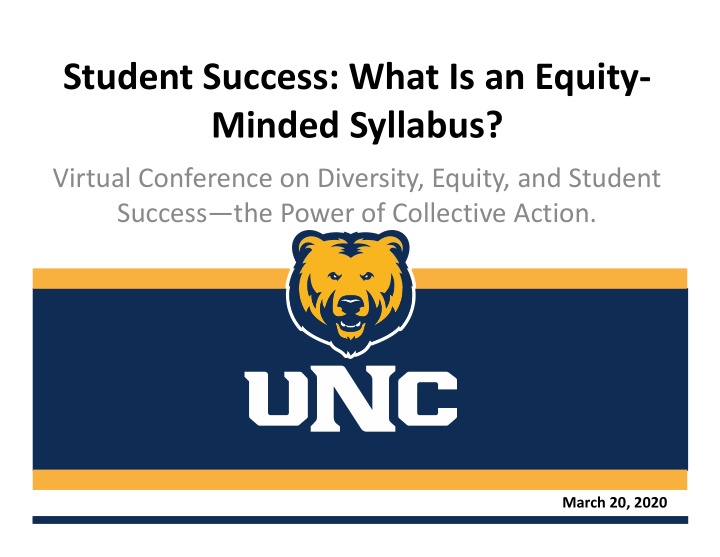



Student Success: What Is an Equity ‐ Minded Syllabus? Virtual Conference on Diversity, Equity, and Student Success—the Power of Collective Action. March 20, 2020
Introductions Dr. Lori Reinsvold Dr. Susan M. Keenan Dr. Talia K. Carroll Associate Director, Math and Director, STEM Inclusive Director, Marcus Garvey Science Teaching Institute Excellence Collective and Cultural Center and Pronouns: She/Hers/Hers Professor of Biological Sciences Adjunct Faculty, Higher Lori.Reinsvold@unco.edu Pronouns: She/Hers/Hers Education and Student Affairs Susan.Keenan@unco.edu Leadership Pronouns: She/Hers/Hers Talia.Carroll@unco.edu Slido www.Slido.com Event Code: 6758
Acknowledgements:
Ways in which your syllabus can demonstrate equity for students Academic • Jargon • Structure Success • Verbal Immediacy Academic • Supporting and Normalizing Struggle Care • Policies • Relevance Connection • Deconstructing
Academic Success: Jargon CUE: All students, but especially minoritized students benefit from “full disclosure of the terms of success.” Giving students access to the language of the institution can improve their chances for success!
Academic Success: Structure Provide students with the information they need to successfully complete the course and navigate college • Include basic information about the course Present information in such a way that a first ‐ time college student can easily make sense of the syllabus • Written clearly, in plain language, with limited academic jargon • Formatted and ordered in a way that highlights what students need to know to maximize their learning and success
Academic Success: Structure
Academic Care: Verbal Immediacy Behavior: Engaging in any behavior that Attendance is Mandatory! negatively affects the teacher’s ability to teach There is no such thing as an and the students’ ability to learn, is direct a excused absence. Up to 90% of violation of the Student Code of Conduct. If your grade will be based your you are being disruptive, you will be asked to participation in activities that take leave the classroom. place in class Attendance: we will be spend much of our time in class working We learn better as part of a community together on activities. Your where everyone has the opportunity to participation in these activities participate and engage. One the first day of weighs heavily on your grade ( its class, we will work together to develop worth 90% ), so to be successful norms for participation and together we will you need to come to class. I have hold each other accountable for our actions listed other tips for success on in class. page 3 of the syllabus
Academic Care: Verbal Immediacy • Creating a Partnership: • Use “We” and “Our” rather than When students believe “I”, “you” or “students” language from a syllabus is • Share your pronouns with students friendly they view and ask them to share their instructors as warm and pronouns with you approachable and believe • Learn and use students’ names and that they are highly ask about preferred names motivated to teach. • Tell the students a little about Harsh language can be yourself and why you excited about intimidating and this course. discouraging for some • Clearly state what you expect from students and hinder their students as learners, and what they success can expect for you as an instructor
Academic Care: Supporting Students
Academic Care: Normalizing Struggle
Academic Care: Policies Classroom Policies to reconsider: • Requiring a note from a doctor for an excused absence • Having a no make up exam policy • Being open and transparent
Connection: Relevance • Connecting material you hope student learn with your course objectives can help students gain a better understanding the relevance of the material • Help your students connect the course objectives, topics, and assessments to their own career and life goals and experiences. Consider: • Including topics/assessments related to the local community of the communities of the students in your course Communicate the value • Offering different forms of assessments that give students of students’ multiple ways to demonstrate their learning and strengths racial/ethnic backgrounds, for • example, as sources of Including readings, activities, and assignments that are learning and culturally relevant and inclusive knowledge
Connection: Deconstructing Consider the Historic Perspective of Higher Education • White, male, middle to upper class, heterosexual, Christian, able ‐ bodied • Consider the stereotypes of people in your field • Consider the identities and intersectionalities of the students in your classroom
Connection: Deconstructing Challenge students to become critically aware of their privileges and Provide opportunities for students to biases . critically examine the norms in higher education and broader social discrimination Include a classroom anti ‐ discrimination policy For articles and other readings: Consider who did the work and where? And how the work funded. Commit to discussing racist or discriminating comments and behavior as they arise in class or on campus
Questions or Comments? For additional Information and examples visit go.unco.edu/STEM ‐ IEC Slido www.Slido.com Event Code: 6758 Dr. Susan M. Keenan Dr. Talia K. Carroll Dr. Lori Reinsvold Director, STEM Inclusive Director, Marcus Garvey Associate Director, Math and Excellence Collective and Cultural Center and Adjunct Science Teaching Institute Professor of Biological Sciences Faculty, Higher Education and Pronouns: She/Hers/Hers Pronouns: She/Hers/Hers Student Affairs Leadership Lori.Reinsvold@unco.edu Susan.Keenan@unco.edu Pronouns: She/Hers/Hers Talia.Carroll@unco.edu
Recommend
More recommend